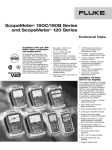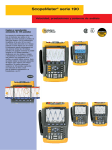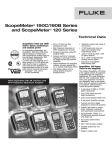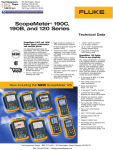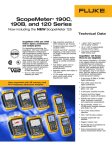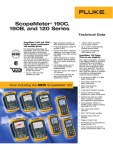Download Troubleshooting without tears with Fluke's 190 ScopeMeter Series
Transcript
Troubleshooting without tears with Fluke’s 190 ScopeMeter Series Application Note Introduction There’s probably not a service engineer on the planet that wouldn’t agree that intermittent electrical faults are the most difficult and frustrating to trace and solve. Although these may seem like random disasters sent to test our patience, invariably they have a sound physical cause. The trick, of course, is to discover what this could be without spending hours monitoring the offending equipment until the elusive fault finally chooses to show itself. This application note, explains how the service engineer’s life can be made infinitely easier with the powerful trouble-shooting features of Fluke’s ScopeMeter® 190 Series. Although usually highly complex, modern equipment is also incredibly robust, with masses of protection circuitry to guard against breakdown induced by, for example, current and voltage surges, mains harmonics, EMI…you name it! This complexity, of course, also has its down side when it comes to maintenance. Intermittent faults in particular, always the curse of the service engineer, can become a major headache to trace in today’s ultra-sophisticated systems with their fast and complex control signals. Fortunately the situation is far from hopeless since although intermittent faults share one infuriating characteristic, i.e. their apparent randomness, they all fall into several welldefined categories. This offers an important clue to tracing and solving them. Troubleshooting with the Fluke ScopeMeter® 190 Any number of factors can lead to spurious signals that may cause equipment to suddenly drop out for no apparent reason. Some of these are equipment related, for example, defective circuitry, dry solder joints, dust or corrosion and overheating. Others such as main fluctuations and voltage spikes due, for example, to airco systems switching on, are related to the mains supply. Identifying the most likely cause requires experience and intuition and, in many instances, a lot of luck. Now, however, with the Fluke ScopeMeter® 190 Series, luck doesn’t have to enter the equation. This new handheld series combines the functions of digital multimeter with digital storage oscilloscope in bandwidths up to 200 MHz and with up to 2.5 GS/s real-time sampling per channel. The series also offers highly innovative troubleshooting features found in the past only on very expensive desktop oscilloscopes. Available for the first time in a portable instrument, these features make the life of service engineer much easier, enabling him or her to trace and solve all manners of intermittent faults. Tracking down faulty wiring Every service engineer knows that bad wiring is often one of the most frustrating intermittent faults to trace. Touching the circuit may trigger the fault but even this is not predictable. And even if a scope is connected to the suspect circuit, it may not be possible to keep a continuous watch on the screen, or something may flash on screen and disappear 2 before its significance can be decided. Wouldn’t it be nice in these situations to be able to look back say over the past 5 or 10 seconds to get another chance at spotting the glitch. Fortunately, the ScopeMeter® 190’s automatic capture and replay feature offers just this possibility. The Scope continuously records the last 100 screens in a FIFO memory. As soon as you spot an anomaly on the scope or suspect something has occurred that you might have missed, the Replay button can be pressed to freeze the last 100 screens and allow you to play them over again. The feature, in fact, allows two sets of 100 screens with individual time stamps to be stored for later recall or download to a PC for more detailed analysis. Catching signal transients with capture and replay Another potential source of intermittent faults – mains transients - can also be picked up with the capture and replay feature. In this case, however, the ScopeMeter needs to be set to trigger on the glitch you suspect is occurring. The instrument then operates in ‘baby-sit’ mode, capturing 100 samples of the event on which it has been set it to trigger. If you’re looking for a voltage spike on the mains, for example, the instrument should be set to trigger on positive- or negativegoing voltage pulses with amplitude slightly larger than main voltage. This method can’t be used; however, to capture glitches that does not have voltage levels higher than the Troubleshooting without tears with Fluke’s 190 ScopeMeter Series signal level. The solution then is to use pulse-width triggering set to capture say negativegoing pulses with duration less than a specified time. With the 200 MHz version (ScopeMeter 199), which has rise and fall times of 1.7 ns, pulses as narrow as 3 ns can easily be captured using pulse-width triggering. Setting the trigger to capture negative-going pulses that last longer than 20 ms can also capture missing cycles on the mains. See figure 1. To see how often the event occurs, just leave the ScopeMeter connected to the circuit for aslong as you like then pressing the Replay key to see and analyse the captured events. You may, for instance, find that the glitch occurs once a day at a particular time corresponding to factory machinery being switched on or off, or weekly on a particular day. Whatever, you should be able to relate the apparent random fault on the equipment to specific external events which could be a big step towards solving the problem. Figure 1 : Setting the ScopeMeter to trigger on negative-going pulses longer than 20 ms will detect missing cycles on the mains Looking for sags and swells with TrendPlot™ Gradual deviations in say voltage or temperature can often signal the start of problems. A copying machine, for example, may operate perfectly for half a day after which problems start. Ambient temperature fluctuations over the day may be the cause of this and it would be useful, in this case, to monitor the temperature over an extended period. The ScopeMeter 190’s TrendPlot feature was introduced specifically for occasions in which relatively long-term monitoring is needed. Operating in the ScopeMeter’s digital multimeter mode, TrendPlot offers the ideal way to locate causes of intermittent problems that occur perhaps only once an hour or once a week. Besides ambient temperature fluctuations, voltage sags or swells on the mains or a failing power supply are other intermittent problems that can be traced with TrendPlot. In this mode, the ScopeMeter acts in effect as a paperless recorder, plotting for up to 8 days the average, minimum and maximum values of any selected scope or meter measurement. Using this feature, long-term irregularities can easily be spotted. TrendPlot also offers the important advantage of accurate time stamping with a resolution down to one minute to show exactly when an irregularity occurs. This can be displayed as either time-of-day or elapsed time, depending on the nature of the change you’re trying to monitor. Whilst TrendPlot is running, the ScopeMeter operates unattended, continuously recording the required data while dynamically setting the vertical amplitude scale to display the maximum and Powerful troubleshooting features of the ScopeMeter 190 Series Automatic capture and replay of 100 screens. This feature allows the past 100 screens to be reviewed to allow a second look at a one-time event. In normal use the feature continuously memorises the past 100 sequential screens, allowing you to scroll through and freeze anything interesting for further analysis. It’s also possible to use the advanced trigger capabilities of the ScopeMeter 190 to record 100 specific events for future analysis. TrendPlot™. For faults that may occur only once in a while over long periods, this feature acts as a ‘paperless recorder’, plotting on screen the minimum, and maximum and average values of a selected parameter over a period up to 8 days with a resolution of 1 minute. ScopeRecord™. This is a continuous sampling mode in which the ScopeMeter stores points (consisting of minimum and maximum values) continuously at the rate of 20 MS/s (mega samples/s). This enables it to capture events as short as 50 ns which can easily be viewed with the mode’s 100x zoom feature. The scope has a 27500-point memory allowing continuous capture for up to 30 hours. minimum values and automatically compressing the time scale to show the complete trend from the start. See figure 2. Analysing fast, complex electrical processes Whilst capture and replay will register fast events such as voltage spikes and drop outs, more complex electrical processes often need something more. A good example is the investigation of power cycles in an UPS (Uninterruptible Power Supply) at switchover from mains to inverter (and vice versa). The quality of the switchover is crucial to the operation of the system – any phase differences induced may cause the power to be momentarily interrupted, which in computer systems or telecommunications equipment could lead to catastrophic loss of data. The signal profile at switchover is unlikely to be known so instead of spending a lot of time attempting to set trigger signals, it would be far better to record an entire sequence covering the event and investigate it afterwards. Figure 2 : Plotting long-term irregularities with ScopeMeter’s TrendPlot feature Troubleshooting without tears with Fluke’s 190 ScopeMeter Series 3 Here’s where the ScopeMeter 190’s ScopeRecord mode comes in. This is a continuoussampling mode in which the scope records points (consisting of minimum and maximum values) at a rate of 20 MS/s. With a 27500-point deep memory, the ScopeMeter can record continuously in this mode for up to 30 hours, capturing glitches as short as 50 ns. What’s more, a 100x zoom function makes the smallest details visible such as the shape of an individual power cycle. Figure 3 shows what happens when an UPS switches over from the inverter to mains supply. Although the switchover would not be visible with a normal display of say 200 ms/div, captured with ScopeRecord; the switchover is clearly visible using a 100x zoom factor. In this case, the display clearly shows that no interruption in supply has occurred, with the main voltage connected and in phase within just a few milliseconds. An ideal partner With the modern trend toward ever faster, more complex electronic control systems, the need for sophisticated test tools can only increase. Whilst advanced bench-top instruments may offer an impressive array of troubleshooting features, their price and lack of portability generally preclude their use by mobile service engineers. These need an instrument that they can easily carry around and, since they never know what to expect on a call out, preferably one with the widest range of trouble-shooting features. Fluke’s ScopeMeter 190 Series fulfils these needs perfectly. Combining portability with a range of advanced features that are both powerful and intuitive to use, it’s the ideal partner for today’s service engineers working in the field. Figure 3 : ScopeRecord shows a voltage irregularity when switching off a UPS Fluke Corporation P.O. Box 9090, Everett, WA USA 98206 Fluke Europe B.V. P.O. Box 1186, 5602 BD Eindhoven The Netherlands For more information call: In the U.S.A. (800) 443-5853 or Fax (425) 356-5116 In Europe/M-East +31 (0)40 2 675 200 or Fax +31 (0)40 2 675 222 In Canada (800) 36-FLUKE or Fax (905) 890-6866 From other countries +1(425) 356-5500 or Fax +1(425) 356-5116 Web access: http://www.fluke.com © Copyright 2000, Fluke Corporation All rights reserved. Data subject to alterations without notice ScopeMeter® is registered trademark of Fluke Corporation Printed in the Netherlands 10/00 Pub_ID 10297-eng




